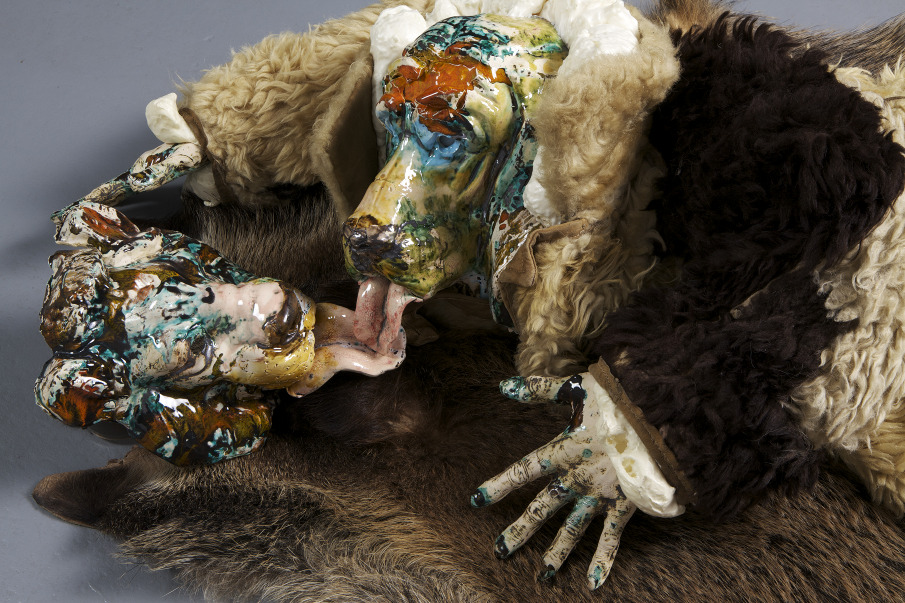
Fragment from “Father is in Town”, ceramics, lamb fur, wild pig fur, foam, 2012. Courtesy of Temnikova & Kasela gallery
When it comes to Kris Lemsalu, one must first lose any frame of rationality. In one sense, Lemsalu could be seen as the trickster of the art world who constantly creates a distinguishing reality around herself, one who is always thirsty for new experiences and can change her appearance or character within a heartbeat.[1] When a trickster’s hyper-performativity spreads into the results of one’s doings: creating rituals and worlds which reveal the hidden shades of reality,[2] then Lemsalu similarly creates new rituals and performative situations which core is semi-fictional. The viewer is unable to remain in a passive role, because the artist has given the sculptures perceptible potential and power, which kick-starts an ineluctable interaction. Her sculptures have an uncanny and alive effect as recognised by Tamara Luuk, the curator of Lemsalu’s latest exhibition project Beauty and the Beast, this year at Tallinn Art Hall, as she mentions: “Kris’s phenomenon lies in making art in the way she lives her life: in her intensity, openness and outgoing relationship with the world, and in a constant effort to map the here and now. Being is what is important for her, and to understand this, she looks to become as much an accurate and genuine figurative equivalent to her surroundings as she possibly can, especially in a way that can preserve the original matter in a living form.”
Other key elements which become important are humour, irony and the absurd. It is known that tricksters often violate principles of social and natural order, playfully disrupting normal life before re-establishing it on a new basis. The trickster’s character is also an example of how it could be possible to overcome a system of oppression from within. This seems to go hand in hand with Lemsalu’s creativity and playfulness, finding humour and laughter to be her main tools for this. She often constructs multilayered allegories which have socially critical tones. Humour creates a kind of distance for the artist to deal with more serious topics and questions, for example birth and death. Still, she uses materials in a very honest and direct way for this, while processing them with her desire for certain balance. The aesthetic fragility of her ceramics is met with combinations of bold colour choices and vigorous forms which create a strong visual image into the viewer’s memory.
Brigita Reinert: Kris, you are a ceramist by education, how did you end up combining ceramics with contemporary art?
Kris Lemsalu: In addition to learning ceramics, I studied sculpture in Vienna for almost five years. So it was quite natural that I would become active in the field of contemporary art. I actually don’t really have faith in art education. I mean, studying theory and art history is definitely important. However, learning to be an artist as such, I don’t really believe in.
If you compared your experience of the art scenes and studying in Vienna to Tallinn, what are the main differences?
The systems are totally different. In Vienna you choose your path by considering which professor you want to study under. There are quite a number of well-known artists who are teaching there. For example, Daniel Richter teaches painting. But if a student who makes mostly video works is interested in him as an artist, he can still apply and end up studying under the guidance of him. My mentor was Monica Bonvicini who I met only once every half a year to discuss my work and progress. The whole program was quite loose with all the lectures and workshops, so all the students could be free to combine their own curriculum.
I think both cities are operating a little in the past, Tallinn more so than Vienna. Vienna’s art scene has a lot more interaction, is more open and information flows faster. When it comes to trends, I think that ceramics will soon be replaced by glass, tapestry and textiles.

Fragment from “Cool Girls Without Hands”, porcelain, fur, skateboard, metal, textile, concrete, 2016. Courtesy of Temnikova & Kasela gallery
Tell us about your working process…
The main themes I like to explore are life, death and time. I usually get inspired by life, and often my works amalgamate a mixture of different stories or texts which I have managed to read. I get ideas from travelling and from people I meet. Overall, I am a really big people person and have a big appetite for new adventures. In this way, I always find some locals who are willing to introduce me to everything and show me what I need.
I usually don’t start making my work before I have a clear visual image of what I want to do. In that sense, I’m not really an experimenter. By the time I start to accomplish my piece, the main work has already been done for it. I think the most important stage is the initial gathering of thoughts and visual imagery, which is also a result of quite long, exploratory work. For example, one of my last works in Tallinn Art Hall, Cool Girls Without Hands (2016), was specifically inspired by Japan and its society. I was curious about their concept of sexuality, the situation between women and men and the disadvantages young girls faced within the society. I examined these questions whilst doing a three-month residency in Tokyo.
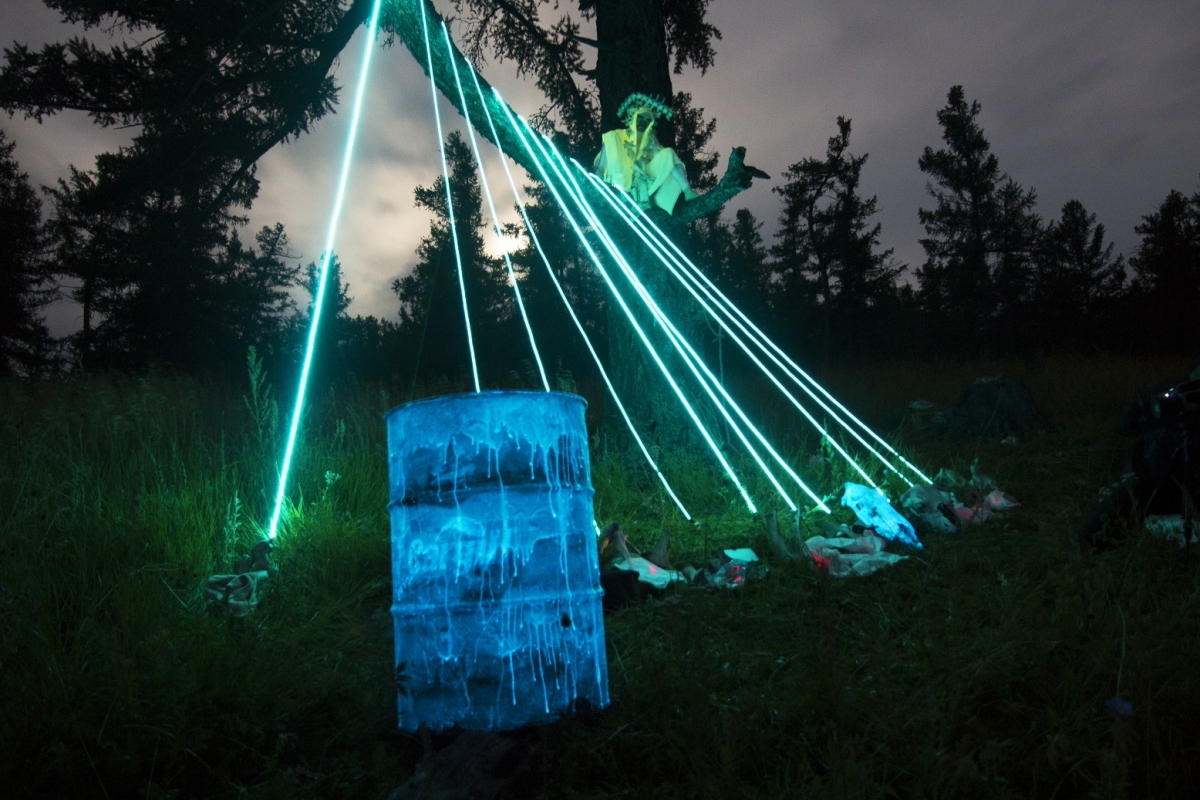
“OVOO”, collaboration with Max Hooper Schneider, Mongolia, 2014. Courtesy of artist
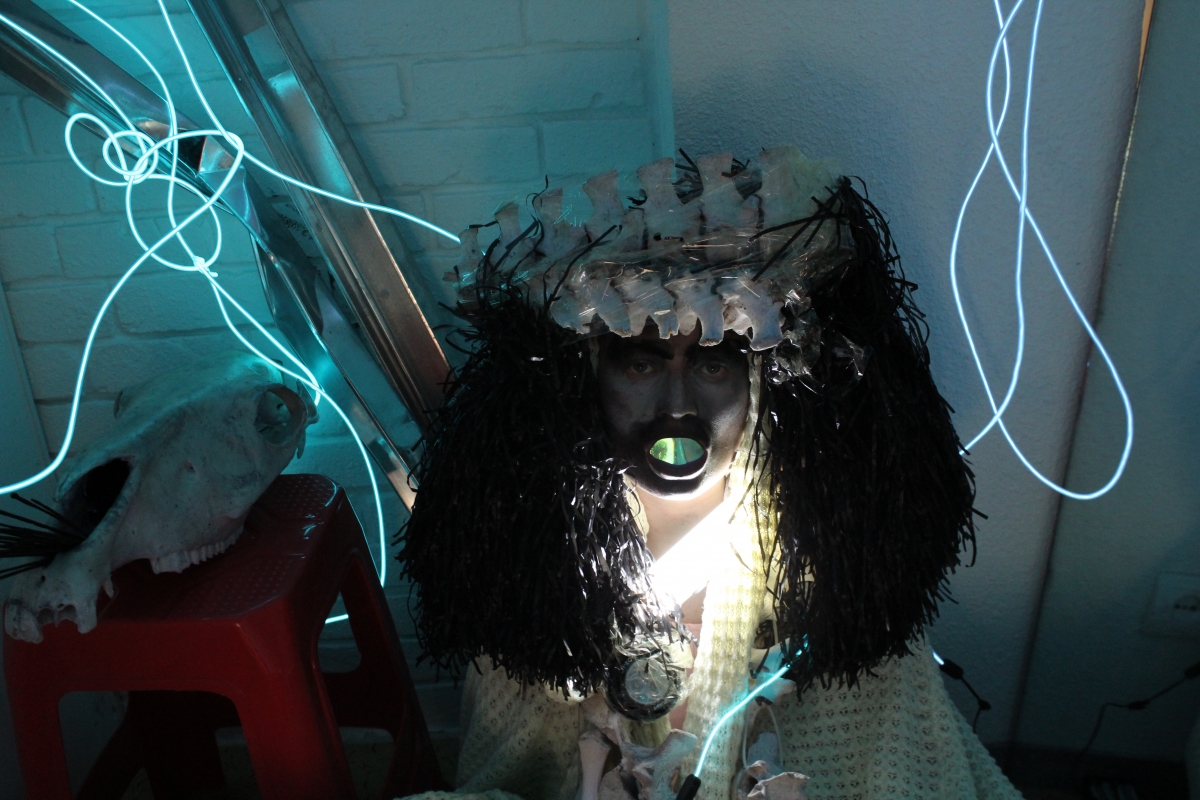
Fragment from “OVOO”, collaboration with Max Hooper Schneider, Mongolia, 2014. Courtesy of artist
In addition to Edith Karlson and Tiit Pääsuke, are there any artists who you have been working closely with, and how do you feel about collaborating with other artists?
One collaborative project I made was called OVOO with American artist Max Hooper Schneider for the Mongolia Land Art Biennial, in 2014. This project was planned together and a video was staged where Max had constructed an installation that surrounded me, and I had created my costume. There were around twenty participating artists, five of which were local and one woman among them had shamanic abilities. When we saw her rites, talked to her and read about shamanism, we finally decided to create our own shaman universe. Though I had another duo-exhibition with the Danish painter, Mads Westrup, in Vienna in 2013, like with Tiit Pääsuke, our works remained parallel to each other in this exhibition, and we did not create a new installation together. In that sense, the Mongolia project was an exception.
Does your last project with artist Tiit Pääsuke and curator Tamara Luuk stand out from your previous projects?
Everything began with Tamara’s idea. She saw our common interests in the core of our practices and when the exhibition was finally installed, I was able to see it too. Since we spent a lot of time together, my new works and Star (2016) in particular, are probably influenced by Tiit’s paintings.
The whole preparation process was really long and lasted about nine months. In this time we became good friends. Tamara organised really nice dinners at her home where we could get to know each other and talk about art. This was a really pleasant experience compared to the chaos and business, which otherwise takes place in the art world.

“Star”, porcelain, textile, cd-s, plastic mirror, foam, silicone, parachute, 2016. Courtesy of Temnikova & Kasela gallery

Fragment from “Star”, porcelain, textile, cd-s, plastic mirror, foam, silicone, parachute, 2016. Courtesy of Temnikova & Kasela gallery
Which other artists are inspiring you at the moment?
I am a big fan of Christoph Schlingensief who represented Germany five years ago at the Venice Biennale in 2011. When I visited Burkina Faso in West Africa, I saw one of his latest and biggest projects Opera Village Africa (Operndorf Afrika)[3], or rather the leftovers of the planned complex, including schools and music studios for the local people. Schlingensief died in 2010. His politically critical work included film, theatre, performance and other media. He was a pretty damn smart artist, with an insanely good sense of humour and irony.
Often, your works are also accompanied by humour and irony. What is the catalyst for this? Is there also some kind of seriousness or sincerity to this?
I think that it is based on my sense of humour, which has had time to develop – thirty-one years exactly! (Laughs). I believe the only way to live is through humour, otherwise, personally, I wouldn’t be able to last very long. Using animals, for example, is one easy and fun solution. It is like a facade or a clever tool, which I can use for talking about something more serious. Indeed, behind all this madness, colour and humour, there often lies something actually pretty serious or with a slight morbid background. For some people, my works remain superficial and funny, but some others are able to see behind first appearances, which make me happy, because my intentions are definitely not univocal. It would not be possible for me to access most of these painful situations without humour.
Recently, I read about an ingenious idea by British musician Donovan, which is also helpful for people engaged in the arts, especially in the situation where one is having a crisis, and asking grand questions like “why am I doing all of this, maybe helping some people directly would make more sense?”. Donovan argues: “I can’t save the world, but if I can share some ideas, people might be able to save themselves”. I think the artist’s role in society is really well characterised by this idea.

“Father is in Town”, ceramics, lamb fur, wild pig fur, foam, 2012. Fragment. Courtesy of Temnikova & Kasela gallery
It has been emphasised that your works are often dealing with the topics of balance and the circle of life, e.g. the case of Star (2016), which also refers to the death of David Bowie. Could you tell us a little more about this notion?
Yes, they interest me as topics, but I also deal with them directly in a visual way when searching for the practical outputs. It’s important for me to keep a certain balance between the details and the materials as I am interested in the constant interaction between the heaviness and lightness. For example, in the work Father is in Town (2012) I combined expanding foam and porcelain. I don’t believe in the hierarchy of materials and I’m trying to achieve equivalence with them. At the moment I am also working with latex, stones and ceramic elements. Hence the amount of the latter is decreasing with time.

“Whole Alone 2”, porcelain, eggs and egg crates, waterbed, metal, hair, 2015. Frieze NY, 2015. Courtesy of Temnikova & Kasela gallery.
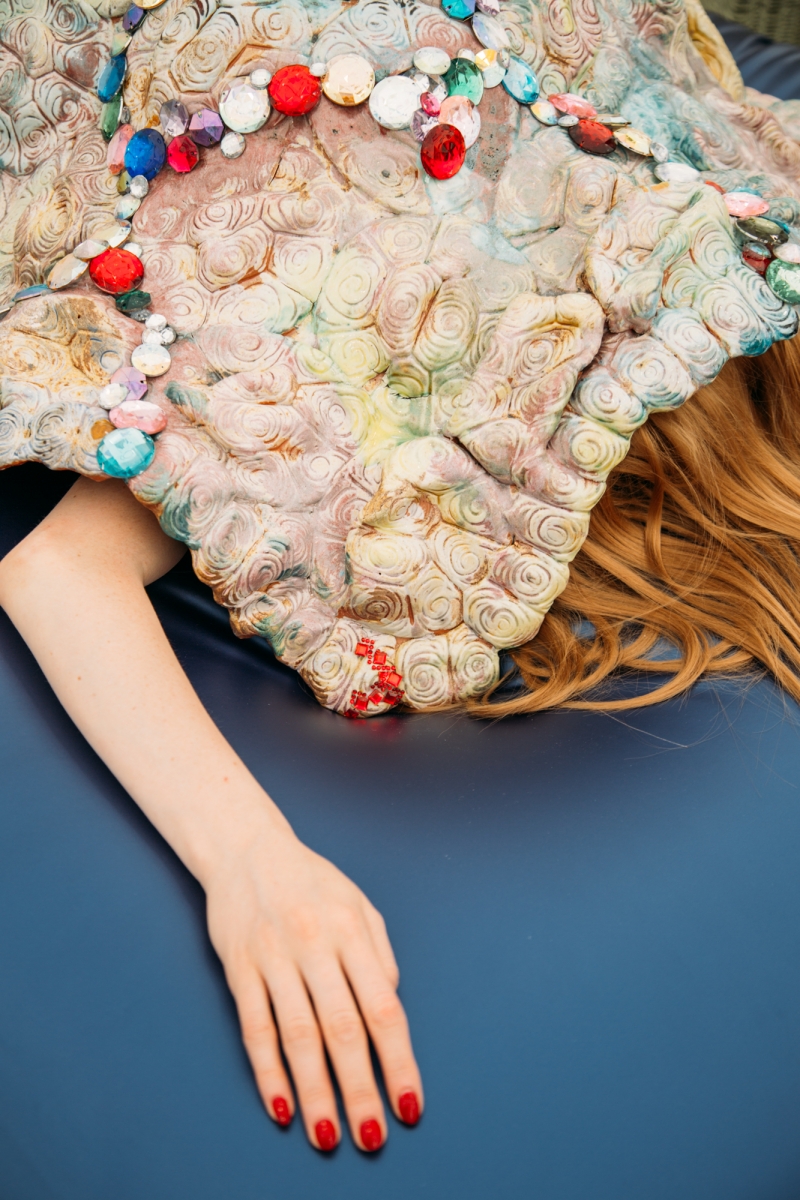
Fragment from “Whole Alone 2”, porcelain, eggs and egg crates, waterbed, metal, hair, 2015. Frieze NY, 2015. Courtesy of Temnikova & Kasela gallery
Where does the medium of performance lie in your work?
I have done performances where I become part of the material because I feel that this is necessary to achieve a certain balance. By this, I mean that for some period of time, I dedicate my body fully to my work. Not as an artist, but as a person with a body made out of flesh and bones.
Yet with Whole Alone 2 (2015) it was quite an interesting situation, since it became important for the viewer to deal with the artist, which activated the viewer to try to create contact with you?
It happened, but I really didn’t think of it that much as I had enough trouble with staying still and calm while lying for four to five hours in a row on a cold waterbed, covered by a hundred-pound heavy shield. I was listening to music and totally separated myself from the atmosphere of the art fair. At that moment, it felt really important that it was me who was there, but if this work was to be performed somewhere else, then it wouldn’t be so important that I perform the work anymore; what is more important is the living presence of woman’s body.
It really seems that questions of the body are often linked in your work with a feminist undertone. What influence do the established norms, in relation to a woman’s body and sexuality, have on your work?
They interest me very much, and I think that all my works are dealing with these topics at some level, but I don’t engage with them so directly. Still, a good example here, which was previously mentioned is the work I did with Japanese manga girls in Cool Girls Without Hands (2016).
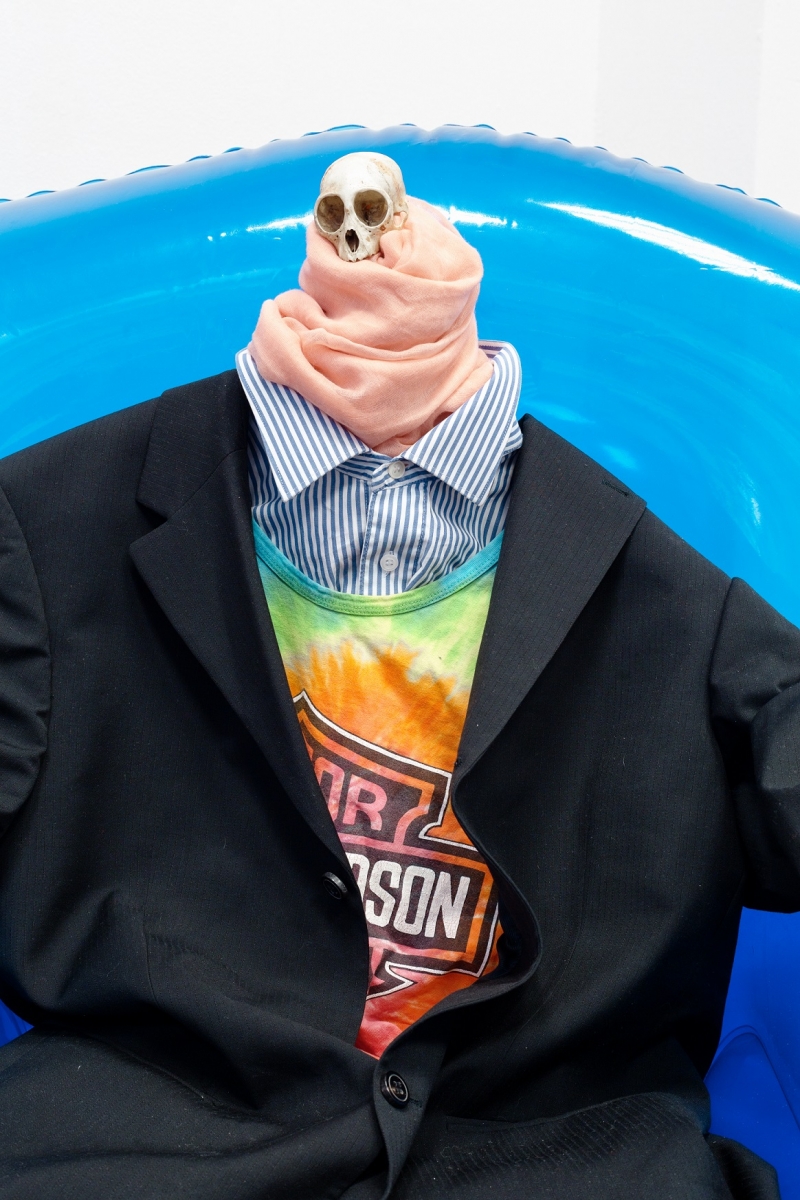
Fragment from “Full Time Friend Erik”, skull, textile, porcelain, plastic, 2015. Courtesy of artist

“Full Time Friend Erik”, skull, textile, porcelain, plastic, 2015. Courtesy of artist
At the same time there is also this enigmatic male character Erik, who performs in one of your most frequently presented works, Full time friend Erik (2015). What is Erik’s story?
Erik was received as a gift by a friend who found him from an African voodoo market in Sierra Leone. I finally named him after one year. As soon as he got his name, he also got a body. He became my friend. But I understood that he wasn’t really a light character, and that he’s also a collection of my own personal characteristics and not always the best. For a long time, I thought about what I could do with him, and now I have found the best option. Erik travels from exhibition to exhibition as he is quite vain, and in this way he gets enough attention. I will always send him as one of the works to the exhibitions I partake in, because people’s attention is like nurture for him.
Along with the majority of your other works, this work really carries the performative element, as Erik occurs very “alive” to the viewer. How important is this kind of effect for you and will you develop it in any future works?
This is not the direct intention, but I am happy to hear that my works can function for you in this way. I can’t really give a rational explanation here. I just think that if it works for the viewer then it’s a successful artwork, and this is the reason why I am doing the thing I do.
Currently, I feel that I have become too comfortable with my expressive language and would like to have a change. A good friend from London once told me the following, that “if you are on top of your game, change your game”. I think this is really important. Lots of artists find their own language, but won’t come out of it anymore because they don’t have the courage to change and are often being dominated by the careerist art market. I would like to devote myself more to dance, music and performance, as music and dance have long been my secret passions. At the moment, I am making a video with a friend where all of our communication is expressed through dance. I would like to step out of my comfort zone and, if necessary, happily fail.
Kris Lemsalu (b. 1985) is an Estonian artist, who lives and works in Vienna. She studied sculpture in Academy of Fine Arts Vienna and ceramics in Estonian Academy of Art. Her work has been shown in many places, including Berlin, Copenhagen and Tokyo. In 2015, she participated in Frieze Art Fair New York, where her work Whole Alone 2 was selected among of five best exhibits by the Frieze New York jury.
[1] Lemsalu started wearing unconventional costumes, playing identity games when she was 15 years old. Whether she was going to a party, market or a song-festival’s parade, it has been a natural way of life for her. Now, she has started to search for opportunities linking this performativity within her art practice.
[2] Türnpu, Anne. Trickster Creating the World and Itself. Doctoral Thesis, Estonian Academy of Music and Theatre, Tallinn 2011, p. 9.
[3]“The Operndorf Afrika” arose from Christoph Schlingensief’s (1960–2010) dream to create an international meeting place. Its goal is to enable people from different backgrounds to work artistically and to engage in artistic exchanges.
























